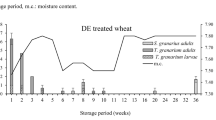Abstract
Heat treatment of dates at the time of harvest, was examined as an alternative to fumigation with methyl bromide, which has been phased out in Israel under the Montreal Protocol. In laboratory studies, the influence of 40°, 45°, 50° and 55°C on the levels of disinfestation and mortality ofCarpophilus hemipterus larvae was examined over a 2-h exposure period. The ratio of the number of insects found outside the feeding sites to the total number of insects, was greatest at 50°C (92.3%), significantly greater than at 40° and 55°C. At 50° and 55°C, 100% mortality was obtained. Since drying temperatures for most date varieties is between 45° and 50°C, and because percent disinfestation and control was most effective at 50°C, these findings were examined under field conditions. Field trials were carried out at a commercial drying station where the crated dates are placed on the ground inside a plastic-clad hothouse. The stacks were covered with plastic liners to form ‘drying ducts’ through which heated air was sucked using fans positioned at the opposite end of the ducts. It was shown that from 1 to 2 h were required for the dates to reach the set temperature of 50°C. During the following 2-h aeration, the dates were exposed to 50°C heated air, after which an examination of infested dates inserted into the drying ducts, and natural infestations showed that successful control and emigration were obtained. This method produced results comparable to those obtained with methyl bromide fumigation, and was suitable as a replacement technology for infestation control.
Similar content being viewed by others
References
Al-Azawi, A.F., El-Haidari, H.S., Aziz, F.M. and Murad, A.K. (1983) Effect of high temperatures on fig mothEphestia cautella in Iraq.Date Palm J. 2 79–85.
Al-Azawi, A.F., El-Haidari, H.S., Aziz, F.M., Murad, A.K. and Al-Saud, H.M. (1984) The effect of high temperatures on the dried fruit beetleCarpophilus hemipterus (L.) a pest of stored dates in Iraq.Date Palm J. 3: 327–336.
Banks, J. and Fields, P. (1995) Physical methods for insect control in stored-grain ecosystems.in: Jayas, D.S., White, N.D.G. and Muir, W.E. [Eds.] Stored Grain Ecosystems. Marcel Dekker, Inc., New York, NY. pp. 353–409.
Donahaye, E. and Navarro, S. (1989) Sensitivity of two dried fruit pests to methyl bromide alone and in combination with carbon dioxide or under reduced pressure.Trop. Sci. 29:9–14.
Donahaye, J.E., Navarro, S., Rindner, M. and Dias, R. (1991) The influence of different treatments causing emigration of nitidulid beetles.Phytoparasitica 19:273–282.
Donahaye, E., Navarro, S., Rindner, M. and Dias, R. (1992) An artificial feeding site to investigate emigration of Nitidulid beetles from dried fruits.J. Econ. Entomol. 85:1990–1993.
Evans, D.E. (1987) Some biological and physical constraints to the use of heat and cold for disinfesting and preserving stored products.Proc. 4 th Int. Working Conference on Stored Products Protection (Tel Aviv, Israel), pp. 149–164.
Fields, P.G. (1992) The control of stored-product insects and mites with extreme temperatures.J. Stored Prod. Res. 28:89–118.
Gonen, M. (1977) Susceptibility ofSitophilus granarius andS. oryzae (Coleoptera: Curculionidae) to high temperature after exposure to supra-optimal temperature.Entomol. Exp. Appl. 21:243–248.
Gonen, M. (1977) Survival and reproduction of heat-acclimatedSitophilus granarius (Coleoptera, Curculionidae) at a moderately high temperature.Entomol. Exp. Appl. 21:249–253.
Heaps, J.W. (1988) Turn on the heat to control insects.Dairy Food Sanit. 8:416–418.
Howe, R.W. (1965) A summary of estimates of optimal and minimal conditions for population increase of some stored products insects.J. Stored Prod. Res. 1:177–184.
Lindgren, D.L. and Vincent, L.E. (1953) Nitidulid beetles infesting California dates.Hilgardia 22:97–117.
Navarro, S., Donahaye, E., Rindner, M. and Azrieli, A. (1998) Control of nitidulid beetles in dried fruits by modified atmospheres.in: Integrated Protection of Stored ProductsIOBC Bull. 21(3):159–163.
Navarro, S., Donahaye, E., Rindner, M., Dias, R. and Azrieli, A. (1993) Integration of controlled atmosphere and low temperature for disinfestation and control of dried fruit beetles.Proc. Int. Conference on Controlled Atmosphere and Fumigation in Grain Storages (Winnipeg, Canada, 1992), pp. 389–398.
TEAP and MBTOC (2003) Handbook on Critical Use Nominations for Methyl Bromide. Technological and Economical Assessment Panel and Methyl Bromide Technical Options Committee. http://hq.unep.org/ozone/teap/Reports/MBTOC/
UNEP (2000) Montreal Protocol on Substances that Deplete the Ozone Layer as Adopted and/or Amended in London 1990, Copenhagen 1992, Vienna 1995, Montreal 1997, Beijing 1999. United Nations Environment Programme, Ozone Secretariat. Article 2H.
Winks, R.G. (1987) Strategies for the effective use of phosphine as a grain fumigant and the implications of resistance.Proc. 4th Int. Working Conference on Stored Products Protection (Tel Aviv, Israel), pp. 335–344.
Zettler, J.L. (1997) Influence of resistance on the future fumigation technology.Proc. Int. Conference on Controlled Atmosphere and Fumigation in Stored Products (Nicosia, Cyprus, 1996), pp. 445–454.
Author information
Authors and Affiliations
Corresponding author
Additional information
http://www.phytoparasitica.org posting Nov. 7, 2005.
Rights and permissions
About this article
Cite this article
Finkelman, S., Navarro, S., Rindner, M. et al. Use of heat for disinfestation and control of insects in dates: Laboratory and field trials. Phytoparasitica 34, 37–48 (2006). https://doi.org/10.1007/BF02981337
Received:
Accepted:
Issue Date:
DOI: https://doi.org/10.1007/BF02981337




